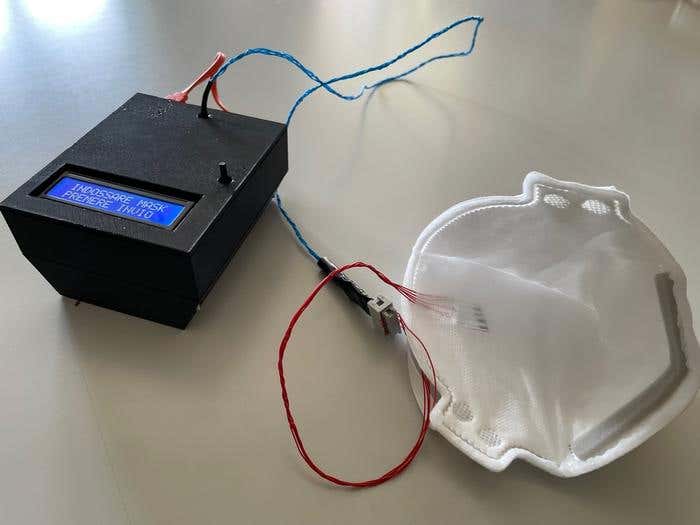First-ever smart face mask can detect kidney disease by analyzing your breath
New smart face mask uses breath sensors to detect kidney disease early and accurately—potentially changing diagnostics forever.

A team from Rome has created a breath-analyzing face mask that detects kidney disease with up to 93% accuracy—changing how we may diagnose CKD. (CREDIT: Adapted from ACS Sensors 2025)
Surgical face masks became a symbol of safety during the COVID-19 pandemic. They helped prevent the spread of viruses, especially through the air. Now, researchers at the University of Rome Tor Vergata and published in the journal, ACS Sensors, have taken that everyday object and turned it into something much more powerful. They've created a smart face mask that doesn't just protect—it also helps diagnose chronic kidney disease (CKD) by analyzing the air you breathe out.
Inside the mask is a special sensor that detects certain chemicals, or metabolites, that come from your breath. These chemicals are linked to how well your kidneys are working. In early tests, this sensor correctly picked up signs of kidney disease in most people. It’s an exciting step toward easier, faster, and cheaper health checks for one of the most common chronic diseases in the world.
The Problem with CKD
Chronic kidney disease is a serious health issue. It happens when your kidneys slowly stop working over time. Normally, your kidneys filter waste from your blood and remove it through urine. But when they’re damaged, those waste products build up in your body and affect everything—from your bones and muscles to your heart and immune system.
The U.S. Centers for Disease Control and Prevention (CDC) estimates that about 35 million Americans have CKD. Many don’t even know it, especially in the early stages. That’s because the signs are often hidden. Diagnosis usually requires a blood or urine test, which many people don’t get unless they’re already sick.
There’s a growing need for simple tools to catch CKD earlier. That’s where this new face mask comes in.
Breath Speaks Volumes
Your breath can say a lot about your health. People with CKD tend to exhale higher levels of certain gases, especially ammonia. This is a sign their kidneys aren’t filtering waste properly. Ammonia is made in the body when proteins break down, and normally the kidneys remove it. But in people with kidney damage, ammonia builds up and can escape through the lungs.
Other diseases can also raise ammonia levels, so it isn’t the only clue. To make the breath test more accurate, researchers looked at other gases too—like ethanol, propanol, acetone, and more. These chemicals also change when someone has CKD.
Related Stories
To detect all these substances, the team designed a special sensor that goes inside a regular face mask. They used a conductive material called PEDOT/PSS, which can sense chemical changes in the air. Then they mixed it with molecules called porphyrins, which are known to react with many kinds of gases. These porphyrins are similar to the ones found in blood and chlorophyll.
The sensor works by changing its electrical resistance when it "smells" different gases. When someone wearing the mask breathes out, the air passes through the sensor, and the changes are recorded.
Putting It to the Test
After building the sensor, the team tested it with 100 people. Half of them had CKD, and half were healthy. The face masks recorded the levels of different gases in each person's breath.
Using computer analysis, the team found patterns that clearly separated the two groups. In fact, the sensor correctly spotted CKD in 84% of patients and accurately ruled it out in 88% of healthy people. With more advanced analysis using wavelet transforms and linear discriminant analysis, the team reached even higher accuracy: about 93% true positives and 87% true negatives.
This is a big deal. Not only could the sensor detect CKD, but it might also be able to tell how advanced the disease is. That means doctors could track how a patient's condition changes over time, without needing blood draws or lab visits.
The researchers used a clever way to test the breath at different rates. They had people breathe in cycles—slow, then fast—to help the sensor pick up more reliable signals. The breath patterns created clear, wavy signals that could be analyzed more easily.
The sensors were placed inside the layers of a regular disposable face mask, rather than just stuck onto the surface. This design kept the sensors close to the breath and protected them from damage. The setup was simple and could be mass-produced at a low cost.
A Glimpse Into the Future
This kind of technology opens the door to a new way of managing health. Sensors like these could help people check their kidney health regularly—at home, at the doctor’s office, or even on the go. The fact that they’re built into something as familiar as a face mask makes them easy to use, especially for older adults or people in areas with limited access to medical care.
The team sees a future where these smart masks could be used for other health conditions too. Many diseases leave traces in your breath—not just CKD, but also liver problems, diabetes, and even some cancers. Breath sensors could one day be as common as thermometers or step counters.
Sergio Bernardini and Annalisa Noce, two researchers who helped lead the study, shared their hope: “The implementation of this technology is expected to enhance the management of CKD patients by facilitating the timely identification of changes in disease progression.”
This could be life-changing. When CKD is caught early, it’s easier to treat. Changes in diet, medication, and lifestyle can slow or even stop the damage. But right now, many people don’t know they have it until it’s too late.
Why It Works
The science behind the sensor is based on the unique behavior of porphyrins. These are ring-shaped molecules that can bind to gases using different types of chemical interactions. In this case, they’re paired with a flexible and conductive polymer, creating a material that reacts when exposed to breath.
As someone breathes, the gas molecules in their breath interact with the porphyrin-coated sensor, causing tiny shifts in electrical resistance. These shifts are picked up and translated into digital signals. Each type of gas creates a different pattern, and when all the sensor responses are combined, a complete picture of the breath chemistry is formed.
Because CKD changes the levels of several chemicals—not just one—the sensor array uses what's called “combinatorial selectivity.” It looks at the combination of gases rather than just the presence of a single one. This makes the results more reliable and less likely to confuse CKD with other illnesses.
Some of the gases that change with CKD include trimethylamine, dimethyl sulfide, and cyclohexanone, in addition to ammonia and acetone. Their levels shift because the kidneys can't remove them as effectively. The average breath ammonia level in CKD patients was found to be about 34 parts per million (ppm), compared to only 2.9 ppm in healthy people.
The Road Ahead
The team hopes to improve the mask’s accuracy even more and test it on larger groups of people. They also want to explore how often people would need to wear the mask for it to be useful—whether daily, weekly, or just during checkups.
Eventually, they imagine a version that connects to a smartphone app, giving users real-time feedback about their kidney health. This could be especially helpful in remote areas or places where access to medical labs is limited.
As more wearable health technologies emerge, it’s clear that the line between everyday items and medical devices is starting to blur. What once was just a barrier against viruses is now becoming a tool to protect you in a much deeper way—by helping catch disease early and improving long-term care.
For millions of people living with CKD or at risk of it, a simple face mask could soon become a lifesaver.
Note: The article above provided above by The Brighter Side of News.
Like these kind of feel good stories? Get The Brighter Side of News' newsletter.



